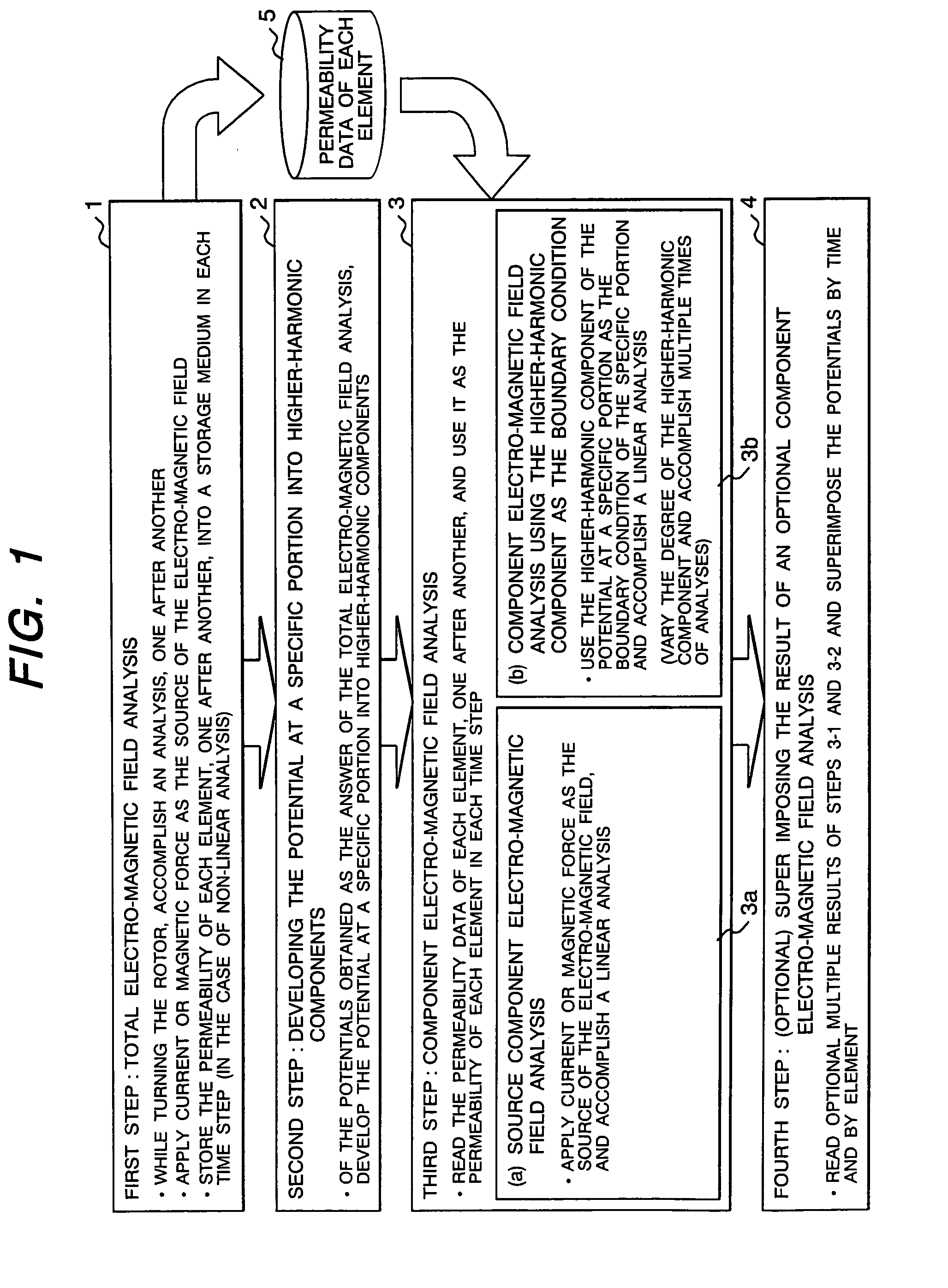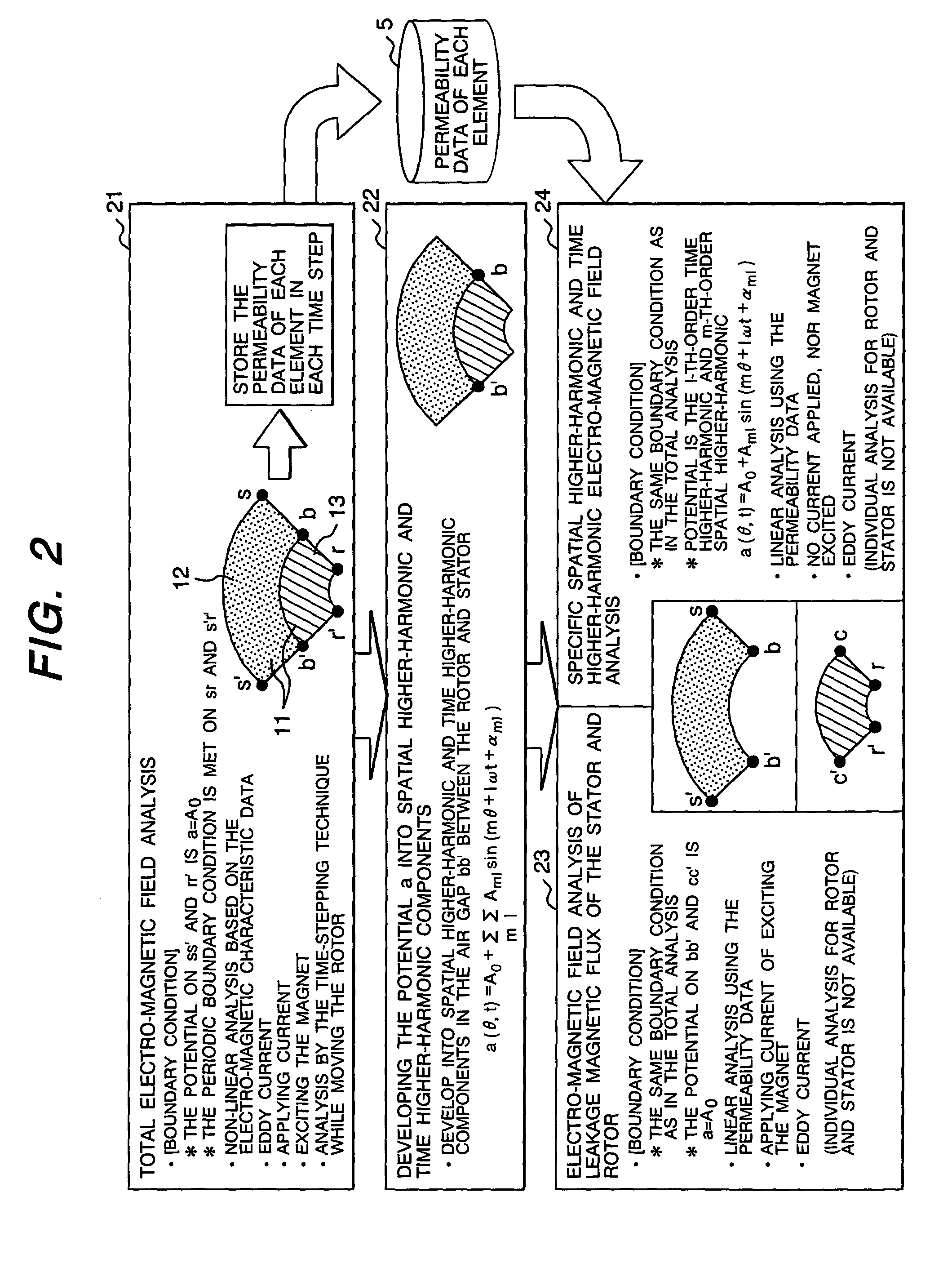Electro-magnetic analysis program of electric rotating machine
a technology of electromagnetic field analysis and electric rotating machines, which is applied in the direction of mechanical roughness/irregularity measurement, nuclear elements, and susceptibility measurement, etc., can solve the problems of inability to independently analyze the electromagnetic field of higher-harmonic components, inability to obtain the electro-magnetic field distribution of each specific higher-harmonic component, and inability to achieve independent electro-magnetic field analysis
- Summary
- Abstract
- Description
- Claims
- Application Information
AI Technical Summary
Benefits of technology
Problems solved by technology
Method used
Image
Examples
first embodiment
[0036]The electro-magnetic field analysis technique of an electric rotating machine according to the present invention is described hereunder, using figures. To start with, the electro-magnetic field analysis technique according to the present invention is described hereunder, using FIG. 1. As shown in FIG. 1, with the electro-magnetic field analysis technique according to this embodiment, a total electro-magnetic field analysis 1 based on a prior art is accomplished in the first step. In this step, an analysis is accomplished, one after another, by the time-stepping technique while turning the rotor at the number of revolutions specified as a computation condition. A magneto-motive force by current or magnet is applied as the source of the electro-magnetic field. In the case of non-linear analysis with consideration given to non-linear electro-magnetic characteristic, the permeability data 5 of each element is saved or stored in each time step. In the second step, of the potentials...
second embodiment
[0039]FIG. 2 shows a flowchart of the electro-magnetic field analysis according to the present invention, and FIG. 3 is a supplemental explanatory figure of the electro-magnetic field analysis of this embodiment. As shown in FIG. 2, the total analysis space 11 comprises an outside peripheral analysis space 12 and inside peripheral analysis space 13, and, with the electro-magnetic field analysis technique of this embodiment, the electro-magnetic field is developed (separated) into both spatial higher-harmonic and time higher-harmonic. Description below is made on an assumption that the total analysis space 11 is a two-dimensional space on a cross-section in the axial direction and the variable for the electro-magnetic field analysis is an axial component of the magnetic vector potential. The outside peripheral analysis space 12 and inside peripheral analysis space 13 represent either the stator side and rotor side, respectively, or the rotor side and stator side, respectively. The ar...
third embodiment
[0054]FIG. 4 shows a flowchart of the electro-magnetic field analysis according to the present invention. The analysis in FIG. 4 differs from that in FIG. 2 in a point that the higher-harmonic handled by the analysis is spatial higher-harmonic only. The total electro-magnetic field analysis 21 is the same as in FIG. 2 and the permeability data of each element is similarly saved. In the spatial higher-harmonic component analysis 25 of the potential a, the potential on the arc bb′, obtained in the total electro-magnetic field analysis 21, is developed into spatial higher-harmonic components as given by Formula (5).
[0055][Formula5]a(θ,t)=A0+∑mAm(t)sin(mθ+αm1(t))(5)
[0056]The electro-magnetic field analysis 23 of leakage magnetic flux of the rotor and stator is the same as in FIG. 2.
[0057]In the specific spatial higher-harmonic electro-magnetic field analysis 26, the permeability data 5 of each element obtained in the total electro-magnetic field analysis 21 is read and assigne...
PUM
 Login to View More
Login to View More Abstract
Description
Claims
Application Information
 Login to View More
Login to View More - R&D
- Intellectual Property
- Life Sciences
- Materials
- Tech Scout
- Unparalleled Data Quality
- Higher Quality Content
- 60% Fewer Hallucinations
Browse by: Latest US Patents, China's latest patents, Technical Efficacy Thesaurus, Application Domain, Technology Topic, Popular Technical Reports.
© 2025 PatSnap. All rights reserved.Legal|Privacy policy|Modern Slavery Act Transparency Statement|Sitemap|About US| Contact US: help@patsnap.com



